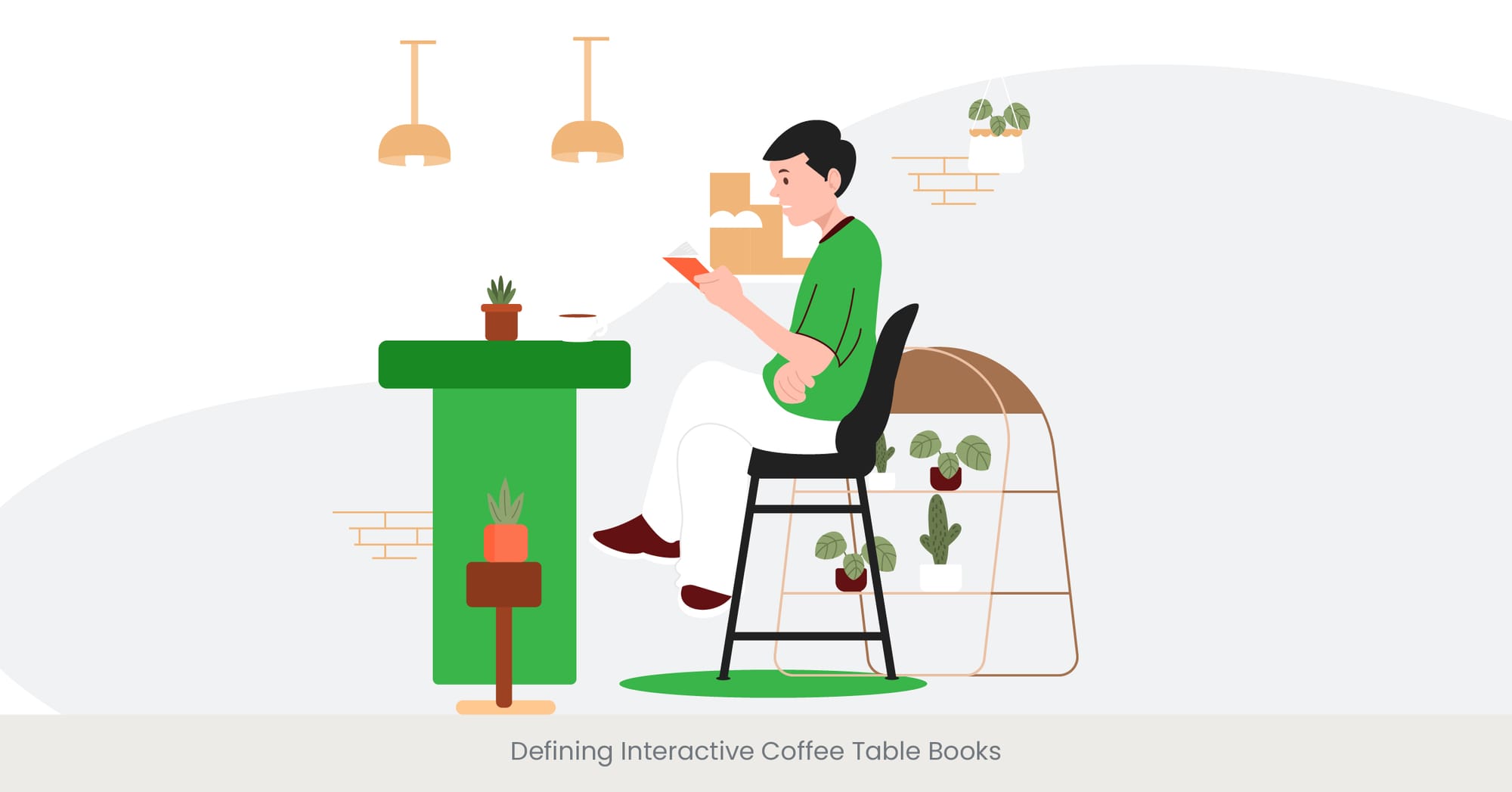
Defining Interactive Coffee Table Books

Introduction to Interactive Coffee Table Books
Interactive coffee table books are an emerging genre that blends traditional print with digital technology, transforming passive reading into an engaging experience. These books incorporate elements such as touch-sensitive pages, integrated multimedia content, and connections to online features, allowing readers to interact with the material in a dynamic way. The aim is to enhance the aesthetic and informational quality of the book, making it not only a piece of art but also an interactive learning tool. Custom coffee table books are at the forefront of this innovation, allowing users to personalize the interactive experience.
Background and Evolution
Historically, coffee table books have been large, lavishly illustrated publications intended for casual reading and display. However, with advances in augmented reality (AR) and digital printing, these books are evolving. By integrating technologies like AR, QR codes, and embedded photos and videos, these books offer readers an enriched, multi-sensory experience. This evolution reflects broader trends in publishing and technology, where the fusion of these ideas with digital and physical media caters to a more tech-savvy audience. Popular coffee table book ideas are now incorporating these technological elements, creating a blend of creativity and innovation.
Real-World Applications and Examples
Several publishers have already embraced this concept with significant success. For example, Wonders of the Universe by Professor Brian Cox features AR elements that bring celestial phenomena into the reader's living room. Another notable instance is Fashion Forward, a collection where readers can view historical fashion and beauty pieces in 3D and see interviews with designers. These examples illustrate how interactive coffee table books can educate and entertain by merging tactile and visual elements with digital interactivity. Many of these books also leverage coffee table book mockups to visualize how the final product might look with interactive components.
References and External Validation
Studies and market research support the growing interest in interactive coffee table books. According to a report by the Smith Publishing Group, sales of AR-enhanced books have increased by 30% in the last two years. Articles featured in both Publishers Weekly and The New York Times highlight the potential of augmented reality coffee table books to revolutionize the publishing industry by adding layers of interactivity to stories that attract and retain readers' attention. These trends suggest that best-selling coffee table books will increasingly feature augmented reality elements.
Technologies Behind Augmented Reality

Introduction to Augmented Reality Technologies
Augmented reality (AR) technology enriches the real world by overlaying digital information onto it, offering users an enhanced interactive experience. This technology, pivotal in developing augmented reality coffee table books, utilizes complex components such as computer vision, image recognition, and sophisticated hardware interfaces. AR technologies can make static content in traditional coffee table books come alive, adding depth and engagement through immersive experiences.
Background and Core Components
The backbone of AR technology lies in its ability to accurately track and interpret the user's environment and superimpose digital information in real-time. This capability is powered by three core technical components: cameras and sensors, processing power, and projection systems. Cameras and sensors collect data from the user's surroundings, which is then processed in real-time to render images or information that seamlessly integrate with the physical world. Projection systems, either through smartphone screens or specialized AR glasses, display the enhanced reality to the user. These technologies provide a robust foundation for creating custom coffee table books that incorporate both physical and digital content.
Real-World Applications and Examples
In the realm of augmented reality coffee table books, AR technologies are used to transform static pages into interactive scenes. For instance, the book Hidden Worlds uses AR to allow readers to explore ancient civilizations by pointing their mobile devices at specific images, which then project detailed 3D reconstructions of archaeological sites. Another example is Birds of Paradise, where readers can observe lifelike animations of birds in flight directly from the book's pages, providing an engaging educational tool that enhances learning.
References and External Validation
Research from the Technology and Media Research Institute indicates that AR increases engagement and retention rates by up to 70% compared to traditional books. Major tech companies such as Google and Apple are continually advancing AR capabilities, which is evident from their frequent updates to ARKit and ARCore, platforms that allow developers to create augmented reality experiences. Industry journals like TechCrunch and Wired regularly feature articles on the impact of AR in education and entertainment, underscoring the significant role AR plays in modern digital interactions. Popular coffee table book ideas often look to these innovations to stay relevant.
Got an idea for your coffee table book? Let’s bring it to life!
Creating Content for Interactive Books

Introduction to Content Creation for Interactive Books
Creating content for interactive coffee table books involves a unique blend of storytelling, graphic design, and technological integration. The challenge lies in developing compelling content that not only engages visually but also interacts seamlessly with digital enhancements. This process requires a multidisciplinary approach, combining the skills of authors, artists, designers, and developers in order to craft experiences that are both informative and immersive. Successful custom coffee table books often rely on a team approach to balance creativity and technology.
Background and Methodology
The methodology for creating content for interactive books often starts with the narrative. Writers and editors must envision and write how text and augmented reality elements can coexist and complement each other. Graphic designers and illustrators then write and visualize this narrative, creating layouts of words and images that are optimized for AR technology. Finally, AR developers bring the visual elements to life, ensuring that the digital overlays function smoothly and are contextually aligned with the written content. Best-selling coffee table books often follow this proven approach to create content that resonates with a wide audience.
Real-World Applications and Examples
An exemplary case of content creation for augmented reality coffee table books is seen in The Art of Wine, where each page offers a detailed exploration of wine regions through interactive maps, photos, and AR videos of vineyards. Readers can virtually travel to meet winemakers and watch the wine-making process, providing a rich, engaging learning experience. Similarly, Cosmos: A Spacetime Odyssey uses AR to allow users to navigate the globe through cosmic phenomena, enhancing the written content with interactive, 3D celestial models. These books often make use of coffee table book mockups to preview how these interactive elements will look in the final product.
References and External Validation
The effectiveness of these approaches is supported by data from educational technology research, which shows a significant increase in both language comprehension and retention when interactive elements are included in learning materials. Reviews in major publications like The Guardian and industry reports from the Augmented Reality for Enterprise Alliance (AREA) discuss how interactive books are setting new standards in educational content delivery, proving particularly effective in subjects requiring spatial understanding and interactive language learning.
Case Studies: Successful AR Coffee Table Books

Introduction to Successful AR Coffee Table Books
The fusion of traditional publishing with augmented reality technology has led to the emergence of several standout AR coffee table books. These books represent the pinnacle of interactive media, blending rich visuals with engaging digital enhancements that draw readers into immersive experiences. This segment highlights specific examples that have set benchmarks in the industry, showcasing the potential of AR to revolutionize reading and educational entertainment.
Background and Development Insights
Each successful AR coffee table book starts with a clear vision and meticulous planning. The development process involves extensive collaboration among writers, designers, technologists, and subject matter experts to ensure that the content is both accurate and engaging. Special attention is given to the seamless integration of AR elements, ensuring they enhance rather than distract from the core content, thereby maintaining the aesthetic integrity of the coffee table book format.
Real-World Applications and Examples
One notable example is Journeys Through the Natural World, which allows readers to explore exotic locations and wildlife through interactive AR experiences. By scanning images with a smartphone, users can see animals in their natural habitats, hear sounds, and access detailed information, making it a compelling educational tool. Another success story is Architectural Wonders, where readers can explore famous buildings and structures in 3D, gaining insights into architectural techniques and historical context not possible with traditional books.
References and External Validation
The success of these books is documented in case studies and reviews in business,, such as those found in Forbes and The Wall Street Journal, which praise the innovative use of AR technology in enhancing the educational value and visual appeal of coffee table books. Industry analysis reports further validate the growing market trend, with projections showing that AR books are likely to see a compound annual growth rate of 30% over the next five years, indicating a robust future for this interactive medium.
Tools and Software for AR Development

Introduction to AR Development Tools
The development of augmented reality (AR) content, especially for interactive coffee table books, requires specialized tools and software that can handle complex visual and interactive elements. These tools enable creators to build immersive experiences that are seamlessly integrated into printed media. This discussion focuses on the leading software platforms and tools that are essential for AR developers looking to innovate within the field of interactive publishing.
Background and Key Features
Modern AR development tools offer a wide range of features tailored to enhance user experience. These include 3D modeling, animation, real-time interaction capabilities, and extensive libraries of assets and effects. Key players in the AR development tool space include Unity3D, ARKit by Apple, and ARCore by Google. Each platform has its strengths, with Unity3D being renowned for its versatility and robustness, ARKit for its advanced face tracking and object recognition, and ARCore for its wide Android device support.
Real-World Applications and Examples
For instance, Unity3D has been instrumental in creating interactive elements for books like Secrets of the Forest, where users can explore forest ecosystems through detailed AR simulations. Using Unity's powerful rendering engine, developers can create lifelike animations and interactive features for stories that engage readers in a dynamic learning process. Similarly, ARKit has enabled features in educational books where historical events are brought to life through AR scenarios that users can view and interact with on their iOS devices.
References and External Validation
The efficacy of these tools is well-documented in developer forums and in feedback from the user community. Numerous tech blogs and digital media outlets, such as TechCrunch and Mashable, often feature articles on the latest developments in AR tools, highlighting how they are being used to push the boundaries of what's possible in interactive media. Further, academic papers and industry reports often cite the critical role these tools play in advancing AR technology, making them indispensable in the creation of augmented reality coffee table books.
Designing User Interfaces for Interactive Books

Introduction to User Interface Design for Interactive Books
Designing user interfaces (UI) for interactive coffee table books involves crafting intuitive and appealing visual elements that enhance user interaction without overwhelming the traditional reading experience. Effective UI design is crucial in custom coffee table books because it directly affects how users engage with augmented content. This part of the development focuses on balancing aesthetic appeal with functional simplicity to create seamless and enjoyable interactions.
Background and Design Principles
The principles of UI design in interactive coffee table books are centered on user-centered design (UCD), ensuring that the interfaces are accessible and easy to navigate for all users, including those without technical backgrounds. This involves using familiar icons, intuitive layouts, and responsive elements that react in real-time to user inputs. Designers must also consider the diverse environments in which these books might be used, from dimly lit rooms to bright outdoor settings, adjusting the UI to accommodate these varying conditions.
Real-World Applications and Examples
In practice, effective UI design can be seen in the interactive book Mysteries of the Cosmos, which features a minimalist interface allowing users to explore the universe through simple swipe and tap gestures. The UI includes icons that are easy to understand and manipulate, bringing constellations, planets, and galaxies to life without requiring complex interactions. Another example is Chefs of the World, where users can access recipes and watch cooking demonstrations via a clean, easy-to-use interface that enhances the reader's experience without distracting from the book's content.
References and External Validation
Industry reviews and user feedback highlight the importance of well-designed UIs in augmented reality coffee table books. Publications like UX Magazine and Design Week often discuss the challenges and successes of UI design in AR, offering insights into how best practices in UI design are evolving in the face of new technologies. Additionally, user studies and academic research confirm that user-friendly interfaces significantly enhance the engagement and satisfaction levels of readers, further validating the need for careful UI design in interactive coffee table books.
Looking to design stunning interactive books? Enhance your AR experience today.
Challenges in Developing AR Books

Introduction to Challenges in AR Book Development
Developing augmented reality (AR) books, especially interactive coffee table books, presents a unique set of challenges that span technical, creative, and logistical areas. These challenges must be skillfully managed to successfully merge traditional book elements with cutting-edge AR technology. This section outlines the main hurdles encountered during the development of AR books and discusses strategies to overcome them.
Background and Technical Hurdles
One of the primary technical challenges is the integration of AR technology with traditional publishing formats. This includes ensuring that the AR elements are compatible across different devices and platforms, which often requires extensive testing and optimization. Additionally, maintaining high performance without compromising the quality of augmented content can be difficult, particularly as the complexity of the interactive elements increases.
Real-World Applications and Examples
For example, the production of Historic Battles: An AR Experience faced significant challenges in aligning the digital augmentations precisely with the physical pages. The developers had to innovate solutions to ensure that AR animations and 3D models matched perfectly with the book's page layout, regardless of the reader's device. Another challenge was encountered in Flora: A Botanical Journey, where developers struggled to balance the file sizes of high-resolution plant images with the need for quick, responsive AR interactions on older smartphones.
References and External Validation
These challenges are widely acknowledged in the industry, as documented in articles from The AR Post and discussions at the International Conference on Augmented Publishing. These sources highlight both the complexity of AR book development and the innovative approaches that developers are employing to address these issues. Technical white papers and case studies often provide insights into successful strategies for overcoming these barriers, demonstrating the ongoing evolution in the field.
Need help overcoming AR challenges? Let’s create interactive books together.
Measuring Engagement and Interactivity

Introduction to Measuring Engagement
In the realm of augmented reality (AR) coffee table books, measuring engagement and interactivity is crucial for understanding how effectively these technologies capture and maintain the reader's interest. Effective measurement strategies provide insights into user behavior, preferences, and interaction patterns, which are essential for refining content and enhancing user experience. This section explores the methodologies and tools used to gauge engagement in interactive books.
Background and Measurement Techniques
The measurement of engagement in AR books typically involves a combination of analytics tools and user feedback mechanisms. Analytics tools can track how often and how long readers interact with AR features, which pages or elements attract the most attention, and where users encounter difficulties. User feedback, collected through surveys and direct observations, complements this data by providing qualitative insights into the user experience.
Real-World Applications and Examples
A leading example is The Journey of Art, an interactive coffee table book for artists that uses embedded sensors and analytics software to track which artworks and AR experiences users engage with most. This data helps publishers understand which features enhance the artist, reader, and artist's experience, guiding future updates and developments. Another case is Ecosystems Explored, which incorporates user feedback forms within the book’s app to gather insights on how interactive features like AR videos and 3D models influence learning outcomes and enjoyment.
References and External Validation
Research published in the Journal of Interactive Media demonstrates that engagement metrics from AR books can significantly predict learning outcomes and satisfaction levels. Industry reports, such as those from the Digital Publishing Innovation Summit, often discuss best practices and ideas for implementing analytics in publishing, emphasizing the importance of data-driven approaches to enhance the interactivity and educational value of AR coffee table books.
Want to see how we’ve helped other brands? Dive into our case studies!
Future Trends in AR and VR Books

Introduction to Future Trends in AR and VR
The landscape of augmented reality (AR) and virtual reality (VR) books is rapidly evolving, driven by technological advancements and changing consumer expectations. As these technologies become more sophisticated and accessible, they are set to transform the way we interact with educational content and storytelling. This section delves into the emerging trends that are shaping the future of AR and VR books, particularly in the interactive coffee table book market.
Background and Technological Advances
Key technological advances fueling these trends include improvements in AR and VR hardware, such as lighter, more comfortable headsets and more powerful mobile devices. Additionally, developments in software, including better image recognition and 3D modeling capabilities, are enabling more complex and realistic interactions within books. These advancements contribute to a more immersive and intuitive user experience, making AR and VR books more appealing to a broader audience.
Real-World Applications and Examples
One promising trend is the integration of AI with AR/VR to create personalized learning experiences. For example, future AR coffee table books might adapt their content in real-time based on the user's interactions and preferences, enhancing the learning and engagement process. Another emerging trend is the use of VR to create fully immersive reading environments where users can experience the setting of a story as if they were part of it, such as walking through the landscapes described in a travel coffee table book.
References and External Validation
Industry forecasts from firms like TechNavio predict a surge in the adoption of AR and VR technologies in publishing, with the market expected to grow by over 30% annually. Furthermore, academic research and white papers highlight the potential of these technologies to revolutionize educational methodologies and increase engagement, particularly in fields requiring spatial understanding and interactive learning.
Stay ahead with AR/VR books! Let’s make your vision a reality.
The Role of Mobile Devices in AR Experiences
Introduction to Mobile Devices in AR
Mobile devices play a pivotal role in the accessibility and popularity of augmented reality (AR) experiences, particularly in the realm of interactive coffee table books. As the primary interface for most AR applications, smartphones and tablets not only provide the necessary technological capabilities but also ensure that AR experiences are widely available to a diverse audience. This section examines how mobile devices facilitate AR interactions and the implications for users and developers.
Background and Device Capabilities
Modern mobile devices are equipped with advanced sensors, high-resolution cameras, and powerful processing capabilities, all of which are essential for supporting sophisticated AR features. These technologies allow mobile devices to perform complex tasks such as spatial detection, image processing, and real-time rendering, making them ideal platforms for delivering AR content. Additionally, the ubiquity of mobile devices ensures that AR experiences can reach a broad audience, significantly impacting how content is consumed and interacted with.
Real-World Applications and Examples
In the context of interactive coffee table books, mobile devices enable users to unlock augmented content simply by pointing their device at a page. For instance, an AR coffee table book about ancient civilizations might allow users to visualize historical artifacts in 3D or watch reenactments of historical events directly from their tablets or phones. These interactions not only enhance the user's sense of understanding but also make the learning process much more engaging.
References and External Validation
The effectiveness of mobile devices in delivering AR experiences is supported by numerous studies and industry reports. For example, a survey by the AR Technology Association shows that over 70% of users prefer using their smartphones for AR experiences due to the convenience and ease of use. Major publications like The Verge and TechCrunch have also discussed the transformative impact of mobile AR on industries ranging from education to retail, highlighting the growing reliance on mobile technologies to drive AR adoption.
Want more design tips? Explore our blog for in-depth insights.
What is an interactive coffee table book?
An interactive coffee table book incorporates digital enhancements such as augmented reality, allowing users to engage with the content in a dynamic and interactive way. These books often include features like 3D models, photos, videos, and interactive graphics that can be accessed through smart devices.
How does augmented reality enhance a coffee table book?
Augmented reality adds a layer of interactivity and a sense of immersion to coffee table books by allowing users to see animations, explore 3D models, and access in-depth additional information simply by scanning images or pages with their mobile devices.
What tools are used to develop AR features in coffee table books?
Developers use AR development platforms like Unity3D, ARKit for iOS, and ARCore for Android to create interactive features. These tools provide the necessary framework for integrating digital content with physical books.
Can you give examples of successful AR coffee table books?
Yes, books like Journeys Through the Natural World and Architectural Wonders are great examples where users can explore natural environments or architectural designs in immersive 3D.
What are the main challenges in creating AR coffee table books?
Key challenges include ensuring that the AR content aligns perfectly with the physical book, managing file sizes for optimal performance, and making the content accessible across various devices and platforms.
How do developers measure engagement in AR books?
Engagement can be measured using a collection, analytics tools that track how users interact with AR features, including the duration and frequency of interactions, and a collection of user feedback mechanisms that gather qualitative data on the user experience.
What future trends are expected in the development of AR and VR books?
Future trends include the integration of AI to personalize experiences, the use of more advanced and comfortable VR headsets for full immersion, and increased use of mobile devices due to their accessibility and advancing capabilities.
How do mobile devices support AR experiences in coffee table books?
Mobile devices, equipped with cameras and sensors, serve as platforms to deliver AR content. They enable users to access AR features easily by scanning book pages, making AR both accessible and portable.
What makes interactive AR books appealing to users?
Interactive AR books offer a more engaging way to learn and explore content, combining visual appeal and beauty of words with interactive technology to create memorable experiences that traditional books can't provide.
Where can one purchase AR coffee table books?
AR coffee table books can be purchased at traditional bookstores, online retailers, or directly from publishers who specialize in interactive and augmented reality content.



%20(1).jpg)
%20(1).jpg)


